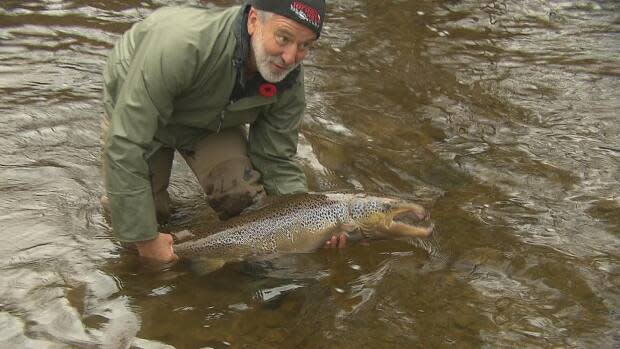Number of Atlantic salmon in Fundy National Park rivers at 32-year high

Researchers and community groups recorded more than 100 endangered Atlantic salmon returning to Fundy National Park rivers this year, the highest number since 1989.
"Being in the business of endangered species recovery, we don't often have a lot of exciting good news stories," John Whitelaw, a species-at-risk ecologist with Parks Canada, told Information Morning Fredericton. "I think it's an understatement to say we were extremely excited about the numbers coming into Fundy National Park this summer."
Teams observed the largest wild-hatched smolt run in 20 years at Fundy National Park, with estimates of more than 4,000 smolts migrating to the ocean.
Whitelaw said estimates suggest that around 80 to 300 fish need to return to the rivers in Fundy National Park each year in order to build a sustainable population.
Whitelaw says adult salmon help deliver marine-derived nutrients to the river, which in turn helps juvenile salmon to develop. Today, more and larger juvenile salmon can be found, compared to when adult salmon numbers were very low.
Whitelaw credits the Fundy Salmon Recovery Project for the increase, a stakeholder group made up of the University of New Brunswick, Fundy National Park, Cooke Aquaculture, the Atlantic Canada Fish Farmers Association, Fort Folly First Nation, Fisheries and Oceans Canada and Parks Canada.
As part of the project, a new system was created to increase the chances of salmon surviving in natural waters.
They collect juvenile salmon that have spent their early lives in rivers, transfer them the world's first Wild Salmon Marine Conservation Farm on Grand Manan, grow the fish to maturity at the farm, then release them to their native rivers to spawn naturally.
"These adults being able to spawn on their own will hopefully produce progeny and offspring that will have never seen human hands or the captive environment," said Whitelaw. "It just builds on this simple premise of the less time spent in captivity, greater chances of survival in the wild."
Remembering wins and losses
Although the current multi-industry model is considered a success, Tim Robinson, the manager of the Fort Folly Habitat Recovery Program, said it has taken years of trial and error, grant writing and on-the-ground work to get to this point.

Around 2010, Robinson says the main strategy was to raise Atlantic salmon brood stock from their rivers, maintain them at the hatchery, and spawn them out, releasing juveniles that came from those spawns back into their rivers, and then collect some of them again a couple of years later.
"The first objective was to preserve what remained of the remnant families, and the live gene bank has done that so that's been successful," said Robinson, who's been involved in the work for over a decade. "But the second main objective was to restore the population in the Bay of Fundy back to self sustaining levels, and that has not been happening."
After joining the Fundy Salmon Recovery Project, Robinson said slowly but surely numbers have started to trend upwards.
"Fort Folly is just a small First Nation, there's no way that we would have had the scope to do something like this. So we're really thankful for all the partnerships that we have," said Robinson.
Pushing for continued success
Robinson said they have been using this technique successfully in Fundy National Park's Pointe Wolfe and Upper Salmon River, along with the Petitcodiac River. He's hopeful it can be applied to other rivers along the Bay of Fundy.
"It's working. We're getting good results, but it's an age old story where we need to secure sufficient funding to keep going," said Robinson. "We bring everything that we can to the table but it's a very expensive project. If you look at it in a bigger picture, the money that is sent down for east coast salmon conservation compared to the money that goes to the west coast salmon conservation initiatives, there's a huge discrepancy there."
He believes the lessons they have learned can be applied by other groups trying to save endangered species.
"It's generated quite a bit of interest, and these days it's hard for any one entity to do something all on their own. Collaboration is key."


